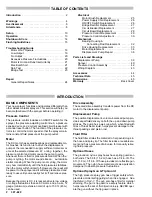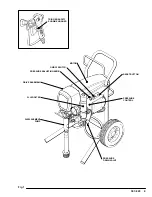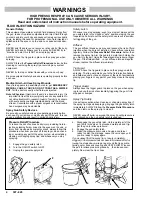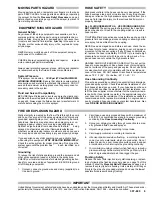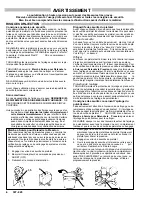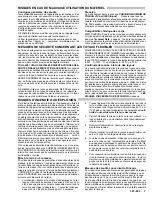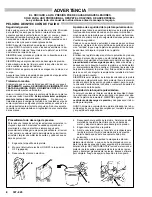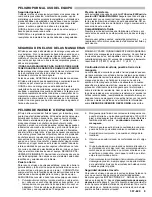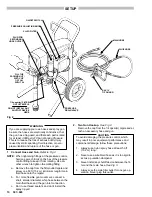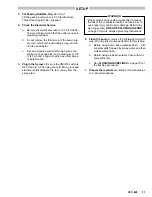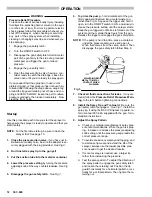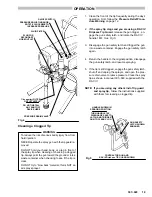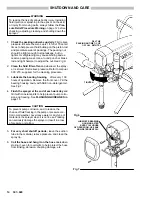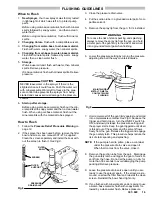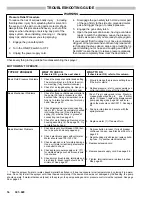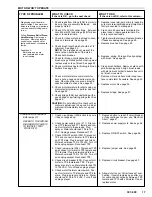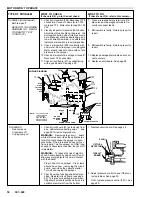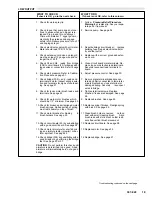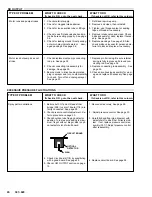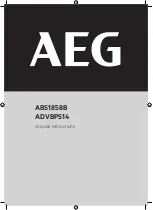
5
307–920
MOVING PARTS HAZARD
Moving parts can pinch or amputate your fingers or other body
parts. KEEP CLEAR of moving parts when starting or operating
the sprayer. Follow the
Pressure Relief Procedure
on page 4
before checking or servicing any part of the sprayer, to prevent it
from starting accidentally.
EQUIPMENT MISUSE HAZARD
General Safety
Any misuse of the spray equipment or accessories, such as
overpressurizing, modifying parts, using incompatible chemi-
cals and fluids, or using worn or damaged parts, can cause them
to rupture and result in fluid injection, splashing in the eyes or on
the skin, or other serious bodily injury, or fire, explosion or prop-
erty damage.
NEVER alter or modify any part of this equipment; doing so
could cause it to malfunction.
CHECK all spray equipment regularly and repair or replace
worn or damaged parts immediately.
Always wear protective eyewear, gloves, clothing and respirator
as recommended by the fluid and solvent manufacturer.
System Pressure
This sprayer can develop
3000 psi (210 bar) MAXIMUM
WORKING PRESSURE.
Be sure that all spray equipment and
accessories used are rated to withstand this pressure. DO NOT
exceed the maximum working pressure of any component or
accessory used in the system.
Fluid and Solvent Compatibility
BE SURE that all fluids and solvents used are chemically com-
patible with the wetted parts shown in the
TECHNICAL DATA
on page 44. Always read the fluid and solvent manufacturer’s lit-
erature before using them in this sprayer.
HOSE SAFETY
High pressure fluid in the hoses can be very dangerous. If the
hose develops a leak, split or rupture due to any kind of wear,
damage or misuse, the high pressure spray emitted from it can
cause a fluid injection injury or other serious bodily injury or
property damage.
ALL FLUID HOSES MUST HA VE SPRING GUARDS ON
BOTH ENDS!
The spring guards help protect the hose from
kinks or bends at or close to the coupling which can result in
hose rupture.
TIGHTEN all fluid connections securely before each use. High
pressure fluid can dislodge a loose coupling or allow high pres-
sure spray to be emitted from the coupling.
NEVER use a damaged hose. Before each use, check the en-
tire hose for cuts, leaks, abrasion, bulging cover, or damage or
movement of the hose couplings. If any of these conditions ex-
ist, replace the hose immediately. DO NOT try to recouple high
pressure hose or mend it with tape or any other device. A re-
paired hose cannot contain the high pressure fluid.
HANDLE AND ROUTE HOSES CAREFULLY. Do not pull on
hoses to move equipment. Keep hoses clear of moving parts
and hot surfaces of the pump and gas engine. Do not use fluids
or solvents which are not compatible with the inner tube and
cover of the hose. DO NOT expose Graco hose to temperatures
above 180
F (82
C) or below –40
F (–40
C).
Hose Grounding Continuity
Proper hose grounding continuity is essential to maintaining a
grounded spray system. Check the electrical resistance of your
fluid hoses at least once a week. If your hose does not have a
tag on it which specifies the maximum electrical resistance, con-
tact the hose supplier or manufacturer for the maximum resis-
tance limits. Use a resistance meter in the appropriate range for
your hose to check the resistance. If the resistance exceeds the
recommended limits, replace it immediately. An ungrounded or
poorly grounded hose can make your system hazardous. Also
read
FIRE OR EXPLOSION HAZARD.
FIRE OR EXPLOSION HAZARD
Static electricity is created by the flow of fluid through the pump
and hose. If every part of the spray equipment is not properly
grounded, sparking may occur , and the system may become
hazardous. Sparking may also occur when plugging in or un-
plugging a power supply cord or using a gasoline engine.
Sparks can ignite fumes from solvents and the fluid
being
sprayed, dust particles and other flammable substances,
whether you are spraying indoors or outdoors, and can cause a
fire or explosion and serious bodily injury and property damage.
If you experience any static sparking or even a slight shock
while using this equipment,
STOP SPRAYING IMMEDIATELY
.
Check the entire system for proper grounding. Do not use the
system again until the problem has
been identified and
corrected.
Grounding
To reduce the risk of static sparking, ground the sprayer and all
other spray equipment used or located in the spray area.
CHECK your local electrical code for detailed grounding instruc-
tions for your area and type of equipment. BE SURE to ground
all of this spray equipment:
1.
Sprayer: connect a ground wire and clamp (supplied) to a
true earth ground.
2.
Fluid hoses: use only grounded hoses with a maximum
f
500 ft (150 m) combined hose length to ensure grounding
continuity. See
Hose Grounding Continuity
.
3.
Spray gun: obtain grounding through connection to a prop-
erly grounded fluid hose and sprayer.
4.
Object being sprayed: according to local code.
5.
Fluid supply container: according to local code.
6.
All solvent pails used when flushing, according to local
code. Use only metal pails, which are conductive. Do not
place the pail on a non–conductive surface, such as paper
or cardboard, which interrupts the grounding continuity.
7.
To maintain grounding continuity when flushing or relieving
pressure, always hold a metal part of the gun firmly to the
side of a grounded metal pail, then trigger the gun.
Flushing Safety
Reduce the risk of fluid injection injury, static sparking, or splash-
ing by following the flushing procedure given on page 15 of this
manual. Follow the
Pressure Relief Procedure
on page 4, and
remove the spray tip before flushing. Hold a metal part of the gun
firmly to the side of a grounded metal pail and use the lowest
possible fluid pressure during flushing.
IMPORTANT
United States Government safety standards have been adopted under the Occupational Safety and Health Act. These standards –
particularly the General Standards, Part 1910, and the Construction Standards, Part 1926 – should be consulted.
Summary of Contents for 231-081
Page 47: ...47 307 920...


